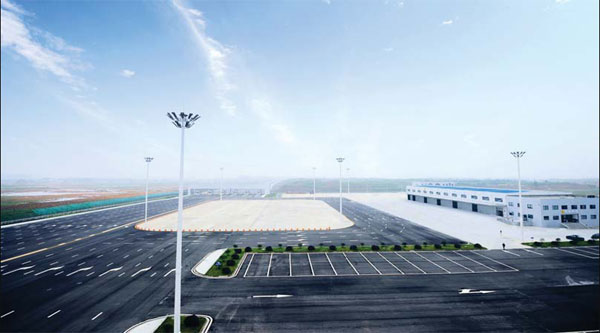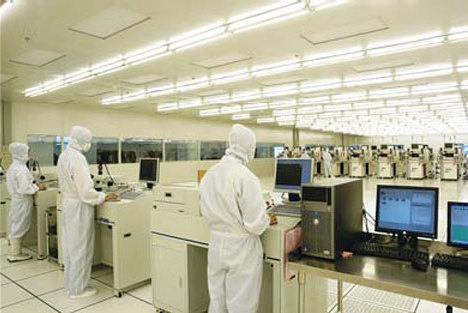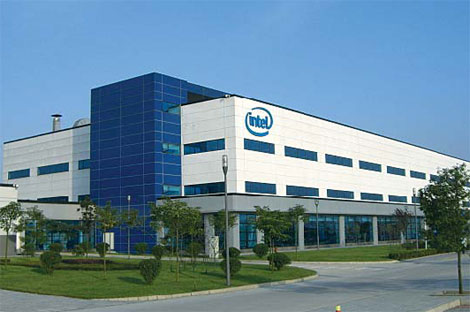Chengdu Special: Foreign trade continues to drive economy of Chengdu
Updated: 2013-03-14 07:43
By Li Yu and Peng Chao in Chengdu (China Daily)
|
||||||||
|
The Chengdu High-tech Comprehensive Bonded Zone is an engine for foreign trade growth in the city. Photos Provided To China Daily |
At a time when the global economy is struggling to regain its footing, Chengdu is emerging as a flourishing major trade hub in the west-central region of China.
In the four years that followed the 2008 international financial crisis, the foreign trade volume of the capital of southwestern China's Sichuan province tripled from $15.34 billion in 2008 to $47.54 billion in 2012, according to the Municipal Bureau of Commerce.
An annual report by the bureau shows that the inland city's foreign trade volume increased by more than 25 percent year-on-year in 2012 while its exports increased by 32 percent.
The city's exports increased to $30.36 billion in 2012, about 79 percent of the province's total. Its imports grew nearly 15 percent to $17.18 billion last year, accounting for 83 percent of the province's total.
Mechanical and electrical equipment and appliances together with high-tech products made up the bulk of last year's exports.
Equipment and appliances accounted for more than 72 percent of the city's total export value, and high-tech products, 53.9 percent.
Furniture, clothing, footwear, pharmaceuticals and agricultural products also contributed greatly to Chengdu's exports.
Behind the surging export value is foreign-invested companies, whose exports rose nearly 56 percent to $16.36 billion in 2012, accounting for 53.87 percent of the city's total exports. Foxconn's Chengdu plant alone exported $12 billion worth of products last year.
Bonded zone
A bonded zone is another dynamic force driving growth.
The Chengdu High-tech Comprehensive Bonded Zone, the second of its kind in western China, was approved by the State Council in 2010. It is home to 40 high-tech enterprises, including integrated circuit giant Intel, tablet manufacturer Foxconn and laptop maker Dell as well as producers of aerospace parts and biopharmaceuticals.
The zone has become an engine for foreign trade growth in Chengdu and the province.
The zone's foreign trade stood at $26.22 billion in 2012, accounting for 55 percent of the city's total and more than 44 percent of that of the province, according to the data provided by the Chengdu Municipal Bureau of Commerce.
"Without the bonded zone, Chengdu wouldn't have been able to attract so many multinationals," said an official of the bureau.
Its distance from the border and the sea is handicap for Chengdu in terms of developing foreign trade, he said, noting that the bonded zone helps to overcome this obstacle by providing easier access to the world.
In addition to the bonded zone, a number of export bases for alternative energy, engineering machinery, footwear, electronics and IT products, and fruit and agricultural products are also playing a role in boosting foreign trade.
Transport facilities
As a city that is far inland, Chengdu's foreign trade has historically been hampered by a lack of transportation, but the situation has changed in recent years.
Railways, highways and airports now link the city to other parts of the country and the world. Now, Chengdu is the fourth major air hub in China after Beijing, Guangzhou and Shanghai, with 143 domestic routes and 56 international routes as of the end of 2012.
Longquanyi district's famed honey peach can now be found in the supermarket aisles of Singapore thanks to new direct flights from Chengdu allowing them to arrive fresh.
Compared with coastal cities, Chengdu has more advantages in developing air transportation because it is closer to the Middle East and Europe. Microchips, iPads and laptops, which are the major exports of Chengdu, can be transported by air faster and at lower costs.
Chengdu's leaders hope to regain the city's past glory as a business and trade center in ancient China. It was one of the two largest commercial cities in the Tang Dynasty (618-907AD). The renowned Chinese poet Du Fu depicted its prosperity in poetry.
The national Great Western Development Strategy and the relocation of industries from coastal cities has given Chengdu a chance to win back its position as one of the most important trade hubs in China.
The target for foreign trade this year is $50 billion, according to statements made by the municipal government in January. The foreign trade volume is expected to reach $110 billion in 2015, putting Chengdu on equal footing with the highly developed cities on the coast.
Production center
The city, long known to the world for its pandas and cuisine, is now gaining fame for producing a large number of high-tech products that are selling on the world market.
Before 2010, Chengdu's laptop exports were practically nonexistent, but in 2012, the city exported 34 million laptops with a total value of $12.85 billion. Most of them are exported to the United States and the European Union.
One out of every two laptop microchips made in the world is now produced here. Two-thirds of the world's iPads come from Foxconn's Chengdu plant, local officials said.
With the arrival of such electronics giants as Lenovo, Dell, Compal and Wistron, Chengdu is poised to become one of the world's most important manufacturing bases for electronics in the coming few years. By 2015, it is projected to generate an annual output of 100 million computers and 200 million tablets, experts said.
You may contact the writers at liyu@chinadaily.com.cn and pengchao@chinadaily.com.cn
|
Pictured here is a production line for integrated circuit packaging and testing at a foreign-funded company in the city. |
|
Intel's Chengdu facility is among 40 high-tech companies in the bonded zone. |
(China Daily 03/14/2013 page13)

 In Photos: 7.0-magnitude quake hits Sichuan
In Photos: 7.0-magnitude quake hits Sichuan
 Li Na on Time cover, makes influential 100 list
Li Na on Time cover, makes influential 100 list
 FBI releases photos of 2 Boston bombings suspects
FBI releases photos of 2 Boston bombings suspects
 World's wackiest hairstyles
World's wackiest hairstyles
 Sandstorms strike Northwest China
Sandstorms strike Northwest China
 Never-seen photos of Madonna on display
Never-seen photos of Madonna on display
 H7N9 outbreak linked to waterfowl migration
H7N9 outbreak linked to waterfowl migration
 Dozens feared dead in Texas plant blast
Dozens feared dead in Texas plant blast
Most Viewed
Editor's Picks

|

|

|

|

|

|
Today's Top News
Live report: 7.0-magnitude quake hits Sichuan, heavy casualties feared
Boston suspect cornered on boat
Cross-talk artist helps to spread the word
'Green' awareness levels drop in Beijing
Palace Museum spruces up
First couple on Time's list of most influential
H7N9 flu transmission studied
Trading channels 'need to broaden'
US Weekly

|

|










